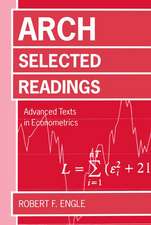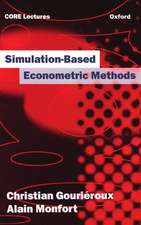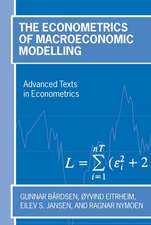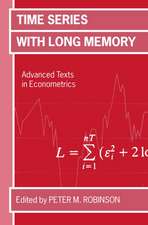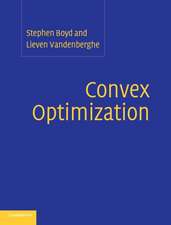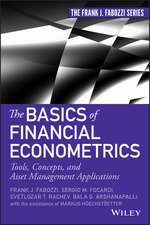Modeling Aggregate Behavior and Fluctuations in Economics: Stochastic Views of Interacting Agents
Autor Masanao Aokien Limba Engleză Paperback – 8 sep 2004
| Toate formatele și edițiile | Preț | Express |
|---|---|---|
| Paperback (1) | 337.07 lei 43-57 zile | |
| Cambridge University Press – 8 sep 2004 | 337.07 lei 43-57 zile | |
| Hardback (1) | 728.56 lei 43-57 zile | |
| Cambridge University Press – 19 dec 2001 | 728.56 lei 43-57 zile |
Preț: 337.07 lei
Nou
Puncte Express: 506
Preț estimativ în valută:
64.50€ • 67.52$ • 53.37£
64.50€ • 67.52$ • 53.37£
Carte tipărită la comandă
Livrare economică 07-21 aprilie
Preluare comenzi: 021 569.72.76
Specificații
ISBN-13: 9780521606196
ISBN-10: 0521606195
Pagini: 280
Dimensiuni: 152 x 229 x 15 mm
Greutate: 0.43 kg
Editura: Cambridge University Press
Colecția Cambridge University Press
Locul publicării:New York, United States
ISBN-10: 0521606195
Pagini: 280
Dimensiuni: 152 x 229 x 15 mm
Greutate: 0.43 kg
Editura: Cambridge University Press
Colecția Cambridge University Press
Locul publicării:New York, United States
Cuprins
1. Overview; 2. Setting up dynamic models; 3. The master equation; 4. Introductory simple and simplified models; 5. Aggregate dynamics and fluctuations of simple models; 6. Evaluation of alternatives; 7. Solving non-stationary master equations; 8. Growth and business cycle models; 9. Example: a new look at the diamond search model; 10. Interaction patterns of agents and distributions of cluster sizes; 11. Example: share markets with two dominant types of participants in a market.
Recenzii
'This is a most welcome treatment of stochastic dynamics in economic models, and its significance for theoretical and applied economics … Professor Aoki has provided a self-contained description of all necessary and relevant concepts of the modelling toolbox, including key stochastic dynamics concepts such as the Master Equation (the backward Kolmogorov-Chapman Equation), the Fokker Planck equation, Jump Markov Processes, Random Partitions and Combinatorial Randomness.' Asia Pacific Journal of Management
'Once again Masanao Aoki has written a book ahead of its time. This time he applies techniques popular in the hard sciences, but alien to most economists, to analyse the dynamic interaction of a large (finite) number of agents (or entities.) He characterises types of agents by their decisions and the movement between types as endogenous transition probabilities. Aoki uses random combinatorial analysis to describe the distribution of types, and the backward Chapman-Kolmogorov equations to describe the aggregate dynamics. This is an innovative approach to characterise a complicated dynamic stochastic economic environment.' Roger Craine, University of California, Berkeley
'In recent years, the economics profession has experienced a growing interest in modelling economic phenomena as the outcome of the interactions of heterogeneous individuals. Although interaction and heterogeneity appear to be natural and pervasive features of modern economies, the formerly dominating tradition of modelling representative agents has eschewed both to a large extent. However, the increasing awareness of the importance of these features also requires the adaptation or development of appropriate technical tools. Professor Aoki has done a great service to the profession by providing a unified treatment of methods for stochastic modelling of large collections of heterogeneous agents. As a companion and sequel to his seminal New Approaches to Macroeconomic Modeling, the present volume both adds advanced material and demonstrates the power of the statistical approach by applying it to important classes of economic models. With its unique coverage and rigourous presentation, the book will immediately become a standard reference in the exciting new area of interacting agent modelling in economics.' Thomas Lux, University of Kiel
'Economists have long taken optimization as first principles in economics. This belief has lead many to the Walrasian or the intertemporal utility maximization model, and has fundamentally changed macroeconomics. Unfortunately, the standard model such as real business cycle theory looks hopelessly unrealistic. It may sound like a paradox that the model which is based on explicit maximization of the representative agent is so unsatisfactory as a macro model. Professor Aoki's book gives us a good answer to this question, and at the same time, provides us with a new methodology in macroeconomics. He convincingly argues that Jump Markov Process is a powerful and fruitful tool in macroeconomics. Professor Aoki explains the method, and also provides examples. The book will be remembered as a landmark.' Hiroshi Yoshikawa, University of Tokyo
'Once again Masanao Aoki has written a book ahead of its time. This time he applies techniques popular in the hard sciences, but alien to most economists, to analyse the dynamic interaction of a large (finite) number of agents (or entities.) He characterises types of agents by their decisions and the movement between types as endogenous transition probabilities. Aoki uses random combinatorial analysis to describe the distribution of types, and the backward Chapman-Kolmogorov equations to describe the aggregate dynamics. This is an innovative approach to characterise a complicated dynamic stochastic economic environment.' Roger Craine, University of California, Berkeley
'In recent years, the economics profession has experienced a growing interest in modelling economic phenomena as the outcome of the interactions of heterogeneous individuals. Although interaction and heterogeneity appear to be natural and pervasive features of modern economies, the formerly dominating tradition of modelling representative agents has eschewed both to a large extent. However, the increasing awareness of the importance of these features also requires the adaptation or development of appropriate technical tools. Professor Aoki has done a great service to the profession by providing a unified treatment of methods for stochastic modelling of large collections of heterogeneous agents. As a companion and sequel to his seminal New Approaches to Macroeconomic Modeling, the present volume both adds advanced material and demonstrates the power of the statistical approach by applying it to important classes of economic models. With its unique coverage and rigourous presentation, the book will immediately become a standard reference in the exciting new area of interacting agent modelling in economics.' Thomas Lux, University of Kiel
'Economists have long taken optimization as first principles in economics. This belief has lead many to the Walrasian or the intertemporal utility maximization model, and has fundamentally changed macroeconomics. Unfortunately, the standard model such as real business cycle theory looks hopelessly unrealistic. It may sound like a paradox that the model which is based on explicit maximization of the representative agent is so unsatisfactory as a macro model. Professor Aoki's book gives us a good answer to this question, and at the same time, provides us with a new methodology in macroeconomics. He convincingly argues that Jump Markov Process is a powerful and fruitful tool in macroeconomics. Professor Aoki explains the method, and also provides examples. The book will be remembered as a landmark.' Hiroshi Yoshikawa, University of Tokyo
Notă biografică
Descriere
This book analyses how a large but finite number of agents interact and what statistical consequences follow.




